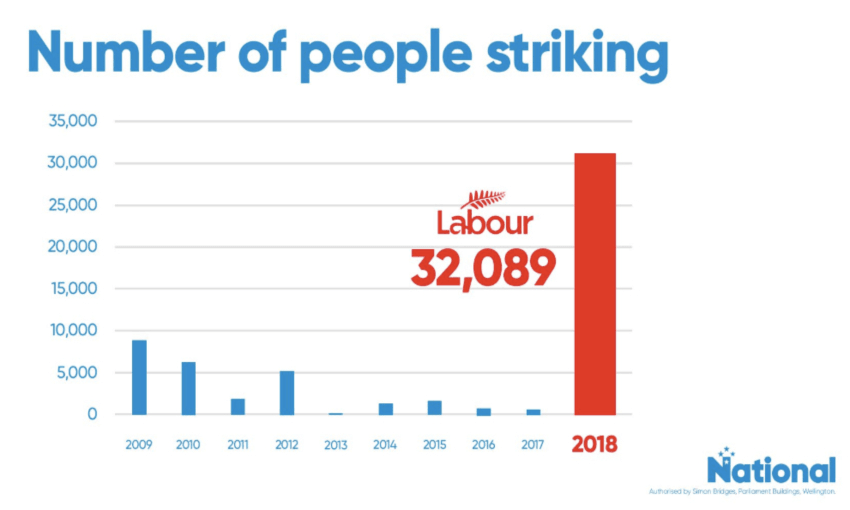It’s a bold claim from Simon Bridges, but has his office pulled a bit of a swifty on the numbers? Alex Braae checks the maths.
Here’s the claim: National Party leader Simon Bridges says in the nine months of the Labour government, there has been more industrial action than under nine years of the National government. Is it true?
Here’s Bridges’ exact wording, just so we can be clear on what we’re talking about. In the press release, he said: “After less than nine months of this government 32,000 workers have been involved in industrial action, or signalled their intention to be – compared to just over 27,000 that undertook strike action in the entire nine years of the previous government.”
Acting PM Winston Peters told Morning Report this morning that such a claim was “demonstrably nonsense” and in true Winstonian fashion, he said that all of he, Guyon Espiner, and the listeners, knew it to be so. Peters made the point that among the major workforces currently planning strike action – for example, 27,000 nurses, or 4000 MBIE and IRD staffers, none of them had actually stepped off the job.
But such a response is comparing apples and fish – Bridges quite clearly says “intention to” strike, which means it doesn’t matter if they have gone on strike or not. And here’s where we get into a bit of difficulty – let’s line up the two tables provided by the National Party office. This is the table they gave for 2018:
Overall, these numbers basically stack up under the definition given. I know for a fact that it’s even slightly higher than the table shows, because I’ve personally reported on a supermarket workers strike that was called, and then called off. Alas that it didn’t make the cut.
Now let’s have a look at the rather more lo-fi table provided by National to outline strikes over the last 30 or so years:
It’s a bit tricky to read, but just so you know, the top line is “number of employees involved in strike action”. The problem is this: The stats are both wrong, and also bullshit.
There’s a subtle difference between the two categories. Say you were going to take these figures to mean exactly the same thing – well, you’d have to decide whether to take nurses and PSA workers out of Labour’s column, or include other workers who have decided on strike action, then changed their mind. The best year to illustrate this is 2016, which has a suspiciously low number of “employees involved in strike action” – 430.
The stats are bullshit, because if you were to compare the two figures, you’d completely wipe the tally just with aviation security workers. They very, very nearly went on strike in the middle of 2016, then called it off at the absolute last moment. I asked the PSA about it and they told me that out of 900 unionised workers overall, 700 were set to strike – some of the workers were represented by the union E Tū. So if the categories are the same and the comparison was being made in good faith, it’s not credible to say the numbers are correct. This is especially the case when you consider that Auckland bus drivers also went on strike in 2016.
But not only that, the stats are also flat out wrong. Because in 2016, 3000 junior doctors went on strike!!! 3000! Three thousand! Here’s some links to stories. Now in fairness, it’s easy to see why this one might have been forgotten. The guy who was health minister at the time, Dr Jonathan Coleman, didn’t exactly depart in a blaze of popularity, so his former colleagues may have collectively wiped their memories of his tenure.
So what does that mean for the rest of the figures? I have no idea, and absolutely no intention of using the rest of the week checking them in detail. But it does go to the heart of the credibility of such a claim – if one year is out by so much, then it’s difficult to have much confidence in them.The PSA’s media spokesperson also kindly suggested I might further frisk the claims by looking into a short strike of thousands of allied health workers in 2015, which I won’t be doing for reasons of time. To be fair to National, they do provide their sources, so one could argue that they put out the numbers in good faith, and it just turns out they were incorrect at the point of source.
Of course, the exact numbers themselves don’t really matter. Making claims like this is a way to attach a news hook to something that feels truthy – that there has been a wave of strikes or strike threats since the new government took office. And that is a completely fair claim to make, because there absolutely has been. Partly it has been Labour’s bad luck that they’ve been holding the bag when collective contracts have come up for renewal and renegotiation. But there is certainly something in the claim that workers will have a better shot at a good deal under this government compared to the last one – acting PM Winston Peters admitted as much on Radio NZ earlier this morning.
One final thing to note: wage growth has been pretty mediocre over the last decade. If this wave of strikes is successful, then at least Labour will be able to say that they’ve presided over some gains for workers there, even if it had to be forced out of them.
The Bulletin is The Spinoff’s acclaimed, free daily curated digest of all the most important stories from around New Zealand delivered directly to your inbox each morning.

